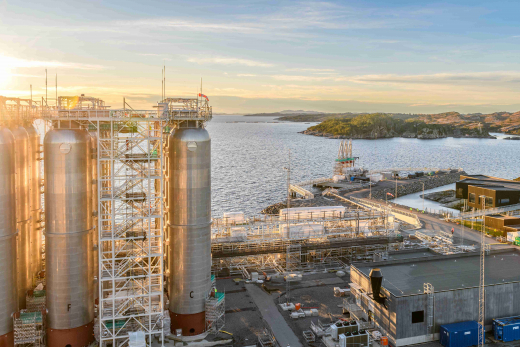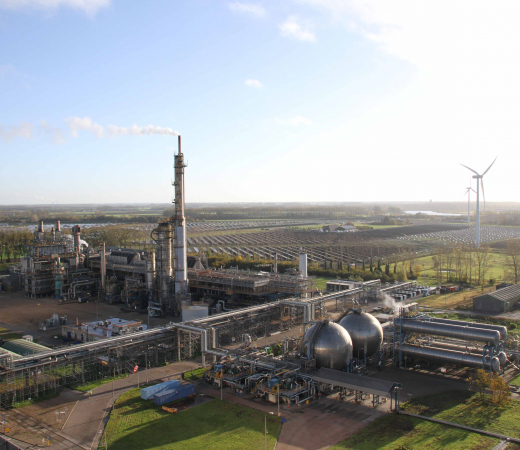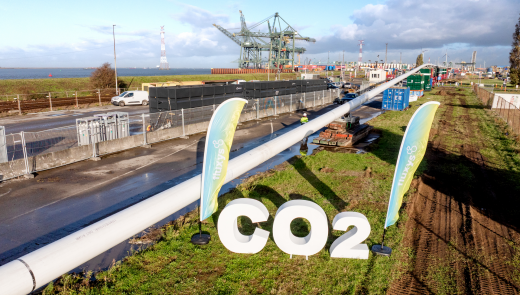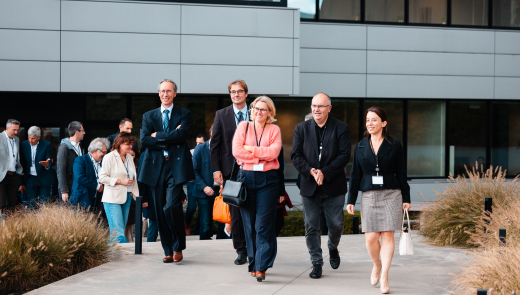
Yara Sluiskil realizes the first cross-border CCS project in the world

Yara Sluiskil will reduce 800,000 tons of CO2 emissions per year from 2026. Thanks to an investment of 194 million euros, the largest fertilizer and AdBlue production location in Northwest Europe guarantees large-scale CO2 reductions. The investment was announced today in The Hague, in the presence of Minister Micky Adriaansens (Economic Affairs and Climate) and Norwegian Ambassador Bård Ivar Svendsen. The Carbon Capture & Storage (CCS) project in Sluiskil is the first project in the world in which the captured CO2 is stored cross-border. The project thus paves the way for the European CO2 reduction ambition, of which CCS is an important part.
Yesterday, during the kick-off of the Hydrogen Week in Brussels, in the presence of Norwegian Minister Aasland, Yara announced that it had signed a purchase contract with Northern Lights to store CO2 deep under the Norwegian seabed from 2025. The participating companies behind the Northern Lights joint venture have 25 years of successful experience with the injection and storage of CO2 in seabeds. Yara Sluiskil has more than 30 years of experience with the capture, purification, liquefaction and shipping of CO2. Magnus Ankarstrand, Executive Vice President of Yara International and CEO of Yara Clean Ammonia: “The partners in this project know what they are talking about. Decades of experience have been combined within the consortium to realize the decarbonization of Europe. At the same time, this project offers unique opportunities for Yara as the largest player in the field of ammonia trading and shipping and the second largest ammonia producer in the world.”
Yara Sluiskil has been capturing CO2 from the production process since the 1980s. About 2.2 million tons per year. More than 60 percent (1.4 million tons) is currently used directly as raw material. Bubbles in soft drinks and beer, Adblue to combat nitrogen emissions from diesel engines, fertilizers, supply as growth material to greenhouses, use for caffeine extraction from coffee beans, anesthetic in slaughterhouses, as well as the transport of pharmaceuticals such as vaccines are a selection of the many applications that knows CO2. This CO2 does not go into the air in Sluiskil, but during use, such as drinking a beer. The remaining 800,000 tons, which are currently vented into the atmosphere as pure CO2, will be liquefied by 2026 and then shipped to Norway to be permanently stored in porous rock 2.6 kilometers deep under the seabed. “Liquefaction and shipping of CO2 is not new for Yara Sluiskil and mainly means expanding existing activities. Moreover, the project fits seamlessly into our vision of becoming a flexible system player,” says Luc Cattoir, Plant Manager and General Manager of Yara Sluiskil.

With this project, Yara will instantly realize more than half of its ambition to reduce 1.5 million tons of CO2 in 2030 compared to 2020. To this end, an Expression of Principles was signed with Minister Adriaansens in The Hague on July 11. Together with other investments that the company already made in the previous year or plans to make in the next two years, a CO2 reduction of 80 percent can be achieved by 2026. In 1990, the company emitted 5.2 million tons of CO2 in Sluiskil and in 2026 this will amount to a maximum of one million tons. In the same period, the volume of end products increased from 3 to 5 million tons per year. The CCS project puts Yara Sluiskil in the position to play a crucial system player role in the energy transition. On the one hand, CO2 reduction is guaranteed through the CCS project and on the other hand, Yara Sluiskil is working in parallel on large-scale flexible intake of green hydrogen. A connection to the national hydrogen backbone is planned from 2026 and in recent years Yara has already prepared its factories for partial direct hydrogen intake. The CCS project therefore guarantees effective and rapid CO2 reduction at all times to combat climate change. When green hydrogen becomes available, less CO2 is available. To reduce the uncertainty regarding the availability of sufficient affordable green hydrogen, Minister Adriaansens is making a conditional subsidy available. The Advisory Committee on Customized Sustainable Industry (AMVI), led by Carolien Gherels, issued a positive advice on this, as part of the Customized Agreements. Minister Micky Adriaansens (Economic Affairs and Climate): “Investments by companies in a sustainable future are the basis of the energy transition. Yara is now actually doing this in the Netherlands with an ambitious CCS project. This investment is therefore also an important part of the customization process that we are now working on with Yara. After positive advice from an independent committee, the cabinet has decided to make a one-off contribution of 30 million euros. By limiting investment risks, the company can start faster to significantly reduce CO2 emissions.”
Met het CCS project halveert Yara Sluiskil bijna in één klap de lokale CO2 uitstoot. Ten opzichte van de totale Nederlandse chemische industrie die in 2022 15,8 miljoen ton CO2 uitstootte betekent dit project een daling van maar liefst 5,1 procent. Dit komt overeen met de CO2 footprint van 100.000 inwoners, oftewel ruim een kwart van de Zeeuwse bevolking.
With the CCS project, Yara Sluiskil halves local CO2 emissions almost overnight. Compared to the total Dutch chemical industry, which emitted 15.8 million tons of CO2 in 2022, this project represents a decrease of no less than 5.1 percent. This corresponds to the CO2 footprint of 100,000 inhabitants, or more than a quarter of the population of Zeeland.
“As a leader, Yara experienced the project as complex, but also extremely valuable,” says Michael Schlaug, Vice President Yara Netherlands. “However, it is more than worth the energy we have put into it, because we are paving the way for CCS as a technology in Europe and boosting a clean hydrogen economy. This investment also means that the parent company sees our branch in Sluiskil as a key asset of the group within Europe. The investment also means the maintenance of ammonia production and technological knowledge, decarbonization of the food chain and thus guarantees strategic autonomy for Europe."

